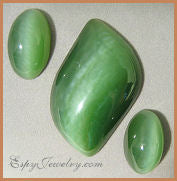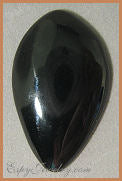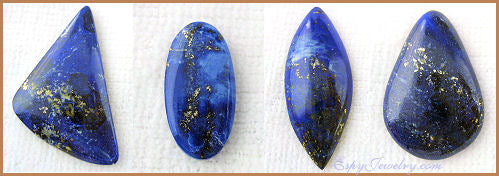Cabs I-L
Cabochons Index by Name
A B C D E F G H I J K L M N O P Q R S T U-V W X-Y-Z
Ice Cream Opalite
See Tiffany Stone.
Imori
See Victoria Stone.
Indonesian Fossil Coral - Mohs 7

Agatized Fossil Coral occurs throughout the world, but the fossilization process does not always preserve the image of the coral polyp. Indonesia has very nice deposits of fossil coral.
Polyp images are described as flowers or mums by many people. It is the sharpness and color of these images that distinquish the better examples of fossil coral. Nice jewelry quality material is only a very small fraction of the agatized fossil coral collected.
Colors include tans, browns, pinks, golden yellows, and white. Natural colors come from iron, manganese, and other elements. Colors may be enhanced by heating in a brick kiln.
Jade - Mohs 6.5-7


There are two types of jade (chinese word = yu) - jadeite and nephrite. Both are found many places throughout the world.
Jadeite occurs in many colors, including green, grayish green, blue-gray, lilac, white, pink, brown, black, red, blue, black, orange, and yellow. The picture above on the right is black jadeite.
Jadeite is a mineral and the gem form is a microcrystaline interlocking crystal matrix. It is a sodium and aluminum rich pyroxene and in its pure form, it is white. Trace impurities give it a large variety of colors. For example, dark greens are caused by iron and lilac is caused by manganese. A highly prized variety called imperial jade is a rich, translucent emerald green with the color coming from chromium. Myanmar has been an important source of imperial jade.
Nephrite occurs in hues of green ranging from a dark green, iron-rich variety to a cream colored, magnesium-rich variety and may be confused with the bowenite variety of serpentine. The more common of the two types of jade, nephrite is actually not a mineral, but a variety of the mineral actinolite with fibrous crystals inter-twinned in a tough compact mass.
Actinolite is the middle member of a amphibole mineral series: tremolite (calcium-magnesium) - actinolite - ferroactinolite (calcium-magnesium-iron). A series occurs when ions can freely substitute between each other. In this case, when iron is predominant the mineral is ferro-actinolite and when magnesium is predominant the mineral is tremolite. Actinolite is the intermediate member. The higher the iron content the greener the color.
Actinolite can form long, thin crystals and fibers. The silky fibrous mineral form is an asbestos. When this form is present in nephrite you can get what is referred to as Cat’s Eye Jade, seen in the first picture above. Cat’s Eye Jade is almost exclusively cut into cabochons where tall, rounded cuts maximize the striking effect. As you move the stone around in your hand the light colored band may sweep across the stone.
For more information & pictures, visit the International Colored Gemstone Assoc.
Jasper - Mohs - 7
Jasper is a subset of chalcedony quartz. It comes in many colors and patterns, including spots, speckles, and banding. Some more popular types include ocean jasper, mookaite, and picture jaspers.
Kyanite - Mohs 4.5 parallel to the crystal axis, 6.5 perpendicular to the axis

While you think of kyanite as being blue, it can also be white, gray, or green. Crystals often do not have even color distribution, showing blue patches within white or translucent areas.
Kyanite cabochons normally show a mix of blue and white and can be quite shiny.
Lapis Lazuli - Mohs 5-6

Lapis lazuli (lapis) is a rock, which means it contains various minerals, whose composition can vary from sample to sample. Minerals seen can include lazurite (blue)(not to be confused with lazulite, a different mineral), sodalite (blue), pyrite (gold flecks), calcite (white), augite, diopside, enstatite, mica, hauynite, hornblende, and nosean.
The blue color of lapis can range from a very rich dark blue with a tinge of purple, to a clear, medium blue, to a light blue, to blue intermixed with white. The price of lapis varies with the color. The dark blues with pyrite flecks are considered the most desirable and are more expensive than the ligher, whiter colors that are often referred to as denim lapis. Denim lapis has its fans as well though, and makes its own unique statement. In either case, people normally prefer a uniform color in the stone rather than big blotches of pyrite or calcium. Lapis is found many places around the world, but the most famous for dark blues is Afghanistan.
Lapis lazuli has stood the test of time as far as its popularity in in jewelry. It has been used since ancient times and has built up a broad base of lore, including metaphysical and healing attributes.
For more information & pictures, visit the International Colored Gemstone Assoc.
Larimar (Blue Pectolite) - Mohs 5-7

A "robins egg" blue stone (sometimes lighter, sometimes darker, sometimes greener), usually with whitish patterns. It may also have interesting red inclusions of hematite. Larimar is a rare stone because it comes from a very limited geographic area - basically the core of the volcanoes in the Dominican Republic on the Island of La Hispanola.
Larimar, also called Atlantis Stone, was originally noticed on the beaches of the island and thought to come from the Carribean. The name Larimar was created by Miguel Méndez by combining LARIssa (his daughter’s name) and MAR (spanish for sea). The larimar found on the beaches was actually washed down from the mountains by the Bahoruco River. Larimar is mined out of the mountains (created by the volcanoes) from vertical pits. The pits are dangerous and easily closed in by cave-ins and hurricanes.
Larimar may be a pectolite (acid silicate hydrate of calcium and sodium) or a pectolite variant. Although pectolite is found around the world, this blue color is only found in the Dominican Republic. The blues and greens come from an inclusion of copper.
Lepidocrocite / Lepidocrocite Quartz
Lepidocrocite is a hydrous iron oxide that forms when iron containing substances rust underwater. It is part of rust scale inside old steel water pipes and is the material causing the stain under those drippy pipes. It forms fiery red, red-brown, brown-black, and sometimes yellow crystals. The crystals can be tarnished with iridescent colors and look like hematite.
Lepidocrocite can occur as inclusions in quartz, creating lovely stones. The quartz may be clear, purple (amethyst), smokey, or other colors. It is normally transparent, allowing you to see the inclusions clearly. It is found in various places, including Brazil and Madagascar.
The safest name for it is Lepidocrocite Quartz. Kokoshanite is a name given by locals to lepidocrocite in quartz from the Minas Geris District in Brazil. You may also see it called harlequin quartz, fire quartz, or strawberry quartz. In general, I would stay away from quartz with these types of names though as they are often glass simulants.
Lepidolite - Mohs 2.5 - 3

Lepidolite is a mica and a lithium ore. Colors include purple, purple-gray, violet, raspberry, and pink, all with lovely mica sparkles in them. Pale lepidolite may be confused with pink muscovite, also a mica.
Limonite - Mohs 4.5 - 5
Limonite is a yellowish-brown to reddish-brown iron ore composed of a mixture of hydrated iron oxide minerals.
Cabochons Index by Name
A B C D E F G H I J K L M N O P Q R S T U-V W X-Y-Z
A B C D E F G H I J K L M N O P Q R S T U-V W X-Y-Z
I
Ice Cream Opalite
See Tiffany Stone.
Imori
See Victoria Stone.
Indonesian Fossil Coral - Mohs 7

Agatized Fossil Coral occurs throughout the world, but the fossilization process does not always preserve the image of the coral polyp. Indonesia has very nice deposits of fossil coral.
Polyp images are described as flowers or mums by many people. It is the sharpness and color of these images that distinquish the better examples of fossil coral. Nice jewelry quality material is only a very small fraction of the agatized fossil coral collected.
Colors include tans, browns, pinks, golden yellows, and white. Natural colors come from iron, manganese, and other elements. Colors may be enhanced by heating in a brick kiln.
J
Jade - Mohs 6.5-7


There are two types of jade (chinese word = yu) - jadeite and nephrite. Both are found many places throughout the world.
Jadeite occurs in many colors, including green, grayish green, blue-gray, lilac, white, pink, brown, black, red, blue, black, orange, and yellow. The picture above on the right is black jadeite.
Jadeite is a mineral and the gem form is a microcrystaline interlocking crystal matrix. It is a sodium and aluminum rich pyroxene and in its pure form, it is white. Trace impurities give it a large variety of colors. For example, dark greens are caused by iron and lilac is caused by manganese. A highly prized variety called imperial jade is a rich, translucent emerald green with the color coming from chromium. Myanmar has been an important source of imperial jade.
Nephrite occurs in hues of green ranging from a dark green, iron-rich variety to a cream colored, magnesium-rich variety and may be confused with the bowenite variety of serpentine. The more common of the two types of jade, nephrite is actually not a mineral, but a variety of the mineral actinolite with fibrous crystals inter-twinned in a tough compact mass.
Actinolite is the middle member of a amphibole mineral series: tremolite (calcium-magnesium) - actinolite - ferroactinolite (calcium-magnesium-iron). A series occurs when ions can freely substitute between each other. In this case, when iron is predominant the mineral is ferro-actinolite and when magnesium is predominant the mineral is tremolite. Actinolite is the intermediate member. The higher the iron content the greener the color.
Actinolite can form long, thin crystals and fibers. The silky fibrous mineral form is an asbestos. When this form is present in nephrite you can get what is referred to as Cat’s Eye Jade, seen in the first picture above. Cat’s Eye Jade is almost exclusively cut into cabochons where tall, rounded cuts maximize the striking effect. As you move the stone around in your hand the light colored band may sweep across the stone.
For more information & pictures, visit the International Colored Gemstone Assoc.
Jasper - Mohs - 7
Jasper is a subset of chalcedony quartz. It comes in many colors and patterns, including spots, speckles, and banding. Some more popular types include ocean jasper, mookaite, and picture jaspers.
K
Kyanite - Mohs 4.5 parallel to the crystal axis, 6.5 perpendicular to the axis

While you think of kyanite as being blue, it can also be white, gray, or green. Crystals often do not have even color distribution, showing blue patches within white or translucent areas.
Kyanite cabochons normally show a mix of blue and white and can be quite shiny.
L
Lapis Lazuli - Mohs 5-6

Lapis lazuli (lapis) is a rock, which means it contains various minerals, whose composition can vary from sample to sample. Minerals seen can include lazurite (blue)(not to be confused with lazulite, a different mineral), sodalite (blue), pyrite (gold flecks), calcite (white), augite, diopside, enstatite, mica, hauynite, hornblende, and nosean.
The blue color of lapis can range from a very rich dark blue with a tinge of purple, to a clear, medium blue, to a light blue, to blue intermixed with white. The price of lapis varies with the color. The dark blues with pyrite flecks are considered the most desirable and are more expensive than the ligher, whiter colors that are often referred to as denim lapis. Denim lapis has its fans as well though, and makes its own unique statement. In either case, people normally prefer a uniform color in the stone rather than big blotches of pyrite or calcium. Lapis is found many places around the world, but the most famous for dark blues is Afghanistan.
Lapis lazuli has stood the test of time as far as its popularity in in jewelry. It has been used since ancient times and has built up a broad base of lore, including metaphysical and healing attributes.
For more information & pictures, visit the International Colored Gemstone Assoc.
Larimar (Blue Pectolite) - Mohs 5-7

A "robins egg" blue stone (sometimes lighter, sometimes darker, sometimes greener), usually with whitish patterns. It may also have interesting red inclusions of hematite. Larimar is a rare stone because it comes from a very limited geographic area - basically the core of the volcanoes in the Dominican Republic on the Island of La Hispanola.
Larimar, also called Atlantis Stone, was originally noticed on the beaches of the island and thought to come from the Carribean. The name Larimar was created by Miguel Méndez by combining LARIssa (his daughter’s name) and MAR (spanish for sea). The larimar found on the beaches was actually washed down from the mountains by the Bahoruco River. Larimar is mined out of the mountains (created by the volcanoes) from vertical pits. The pits are dangerous and easily closed in by cave-ins and hurricanes.
Larimar may be a pectolite (acid silicate hydrate of calcium and sodium) or a pectolite variant. Although pectolite is found around the world, this blue color is only found in the Dominican Republic. The blues and greens come from an inclusion of copper.
Lepidocrocite / Lepidocrocite Quartz
Lepidocrocite is a hydrous iron oxide that forms when iron containing substances rust underwater. It is part of rust scale inside old steel water pipes and is the material causing the stain under those drippy pipes. It forms fiery red, red-brown, brown-black, and sometimes yellow crystals. The crystals can be tarnished with iridescent colors and look like hematite.
Lepidocrocite can occur as inclusions in quartz, creating lovely stones. The quartz may be clear, purple (amethyst), smokey, or other colors. It is normally transparent, allowing you to see the inclusions clearly. It is found in various places, including Brazil and Madagascar.
The safest name for it is Lepidocrocite Quartz. Kokoshanite is a name given by locals to lepidocrocite in quartz from the Minas Geris District in Brazil. You may also see it called harlequin quartz, fire quartz, or strawberry quartz. In general, I would stay away from quartz with these types of names though as they are often glass simulants.
Lepidolite - Mohs 2.5 - 3

Lepidolite is a mica and a lithium ore. Colors include purple, purple-gray, violet, raspberry, and pink, all with lovely mica sparkles in them. Pale lepidolite may be confused with pink muscovite, also a mica.
Limonite - Mohs 4.5 - 5
Limonite is a yellowish-brown to reddish-brown iron ore composed of a mixture of hydrated iron oxide minerals.
Cabochons Index by Name
A B C D E F G H I J K L M N O P Q R S T U-V W X-Y-Z
 Unique, One-of-a-Kind Settings for Unique, One-of-a-Kind Stones
Unique, One-of-a-Kind Settings for Unique, One-of-a-Kind Stones